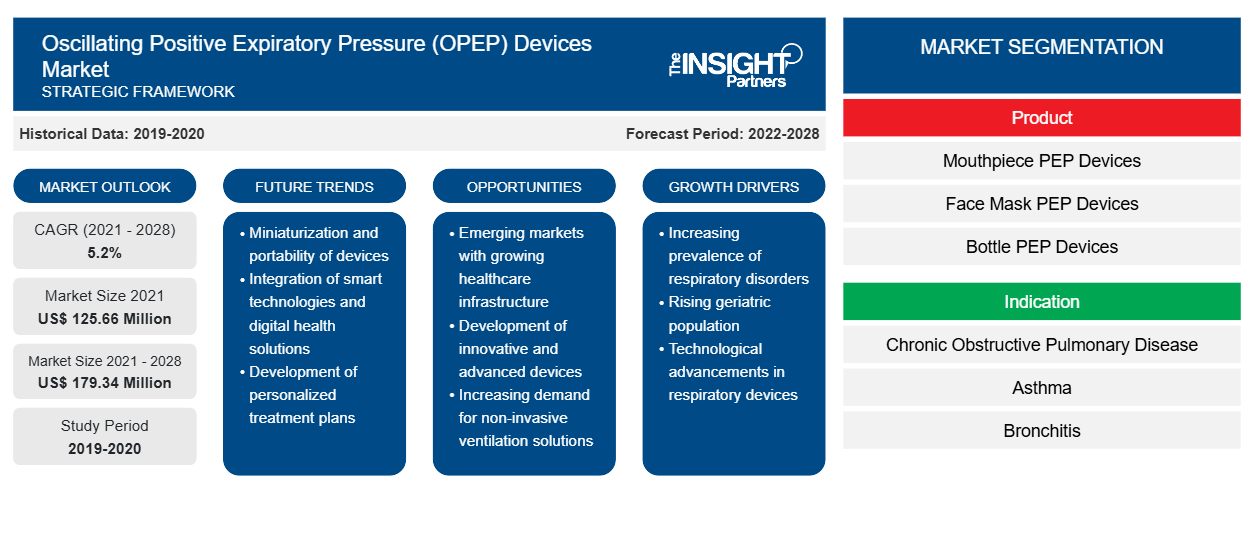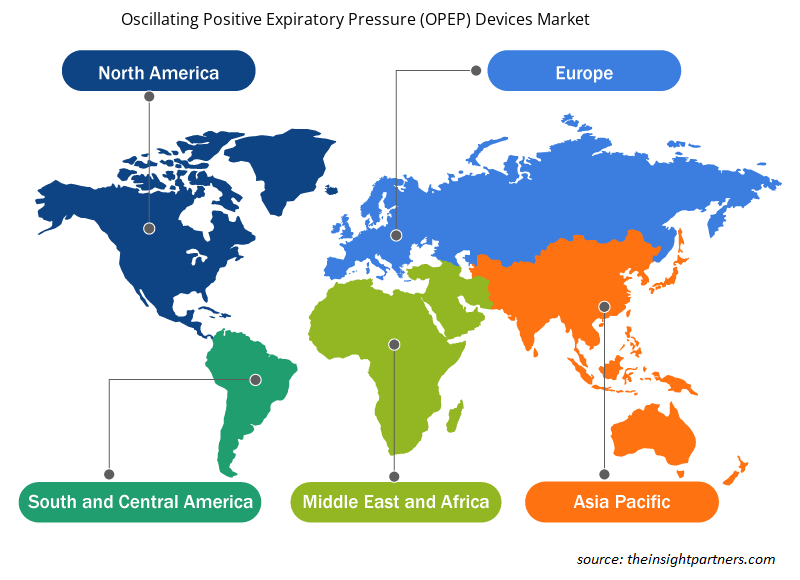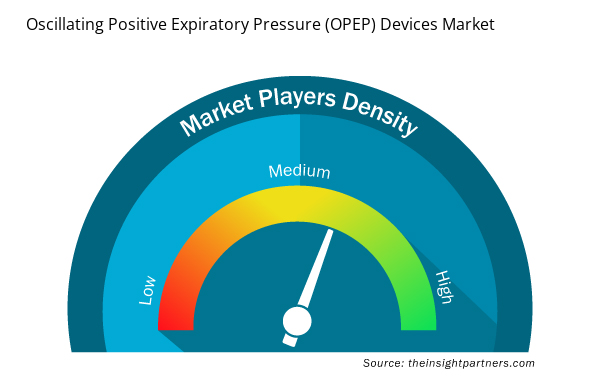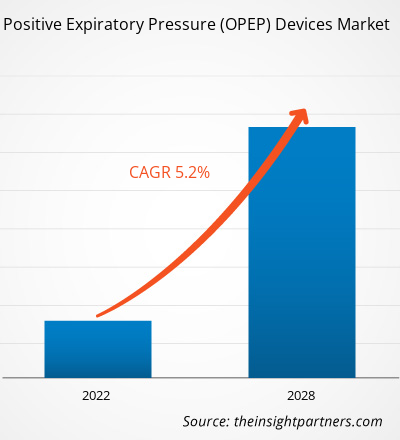Le marché des dispositifs à pression expiratoire positive oscillante (OPEP) devrait passer de 125,66 millions USD en 2021 à 179,34 millions USD en 2028 ; il devrait croître à un TCAC de 5,2 % au cours de la période 2021-2028.
Les appareils à pression expiratoire positive oscillatoire (OPEP) sont utilisés en complément de la physiothérapie respiratoire traditionnelle (CPT) pour faciliter l'évacuation des sécrétions respiratoires chez les personnes qui ne peuvent pas tousser, en particulier celles atteintes de maladies chroniques. L'utilisation des appareils à pression expiratoire positive oscillatoire est encore limitée dans les troubles chroniques des voies respiratoires tels que la fibrose kystique, la bronchectasie, la bronchite, l'asthme bronchique et le syndrome de dyskinésie ciliaire primaire. Dans la bronchopneumopathie chronique obstructive (BPCO), les appareils à pression expiratoire positive oscillatoire (OPEP) aident à l'évacuation des expectorations.
La croissance du marché des dispositifs à pression expiratoire positive oscillante (OPEP) est attribuée à la prévalence croissante de la bronchopneumopathie chronique obstructive (BPCO) et de l'asthme, ainsi qu'aux progrès des technologies médicales. Cependant, la faible sensibilisation et l'accès limité aux dispositifs OPEP freinent la croissance du marché.
Personnalisez ce rapport en fonction de vos besoins
Vous bénéficierez d'une personnalisation gratuite de n'importe quel rapport, y compris de certaines parties de ce rapport, d'une analyse au niveau des pays, d'un pack de données Excel, ainsi que de superbes offres et réductions pour les start-ups et les universités.
Marché des dispositifs à pression expiratoire positive oscillante (OPEP) : informations stratégiques

- Obtenez les principales tendances clés du marché de ce rapport.Cet échantillon GRATUIT comprendra une analyse de données, allant des tendances du marché aux estimations et prévisions.
Perspectives du marché
La prévalence croissante de la bronchopneumopathie chronique obstructive (BPCO) et de l'asthme stimule la croissance du marché
L’incidence de la BPCO et de la fibrose kystique est en hausse dans le monde entier. Selon l’Organisation mondiale de la santé (OMS), les exacerbations de la BPCO sont des événements critiques. L’invalidité et la mortalité liées à la BPCO stimulent la demande de dispositifs OPEP. Selon le Center for Disease Control and Prevention (CDC), environ 9 millions d’adultes ont reçu un diagnostic de bronchite chronique en 2018. En outre, l’asthme devient courant chez les personnes de tous âges, de tous sexes et de toutes races. Selon le CDC, environ 300 millions de personnes dans le monde souffrent d’asthme, et 100 millions de personnes supplémentaires devraient s’ajouter d’ici 2025. La prévalence, la gravité et la mortalité de l’asthme varient considérablement aux États-Unis. L’asthme touche plus de 25 millions de personnes aux États-Unis, ce qui équivaut à 7,7 % des adultes et 8,4 % des enfants. Selon le rapport mondial sur l’asthme de 2018 sur Auckland, en Nouvelle-Zélande, l’asthme se classe au 16e rang des principales causes d’invalidité et au 28e rang des principales sources de morbidité, selon l’évaluation des années de vie corrigées de l’invalidité. Il est courant dans les pays à revenu élevé, alors que la majorité des décès liés à l’asthme surviennent dans les pays à revenu faible et intermédiaire. Par conséquent, la prévalence croissante de la BPCO et de l’asthme stimule la demande de dispositifs d’élimination des muqueuses, tels que les dispositifs OPEP, ce qui renforce la croissance du marché des dispositifs à pression expiratoire positive oscillante (OPEP).
Informations basées sur les produits
Le marché des dispositifs à pression expiratoire positive oscillante (OPEP), en fonction du produit, est segmenté en dispositifs PEP à embout buccal, dispositifs PEP à masque facial et dispositifs PEP à flacon. Le segment des dispositifs PEP à embout buccal détenait la plus grande part du marché en 2021. De plus, il devrait enregistrer un TCAC de 5,3 % sur le marché au cours de la période de prévision. Le PEP à embout buccal aide à éliminer le mucus des poumons. Il peut également prévenir l'affaissement des poumons ou ouvrir les zones qui se sont affaissées. L'un des principaux facteurs qui stimulent le marché des dispositifs PEP à embout buccal est la croissance de la population âgée, associée à des taux plus élevés de maladies chroniques telles que la bronchopneumopathie chronique obstructive (BPCO) et l'asthme. Selon les Centers for Disease Control and Prevention (CDC), environ 9 millions de personnes recevront un diagnostic de bronchite chronique d'ici 2020, ce qui accroîtra le besoin de dispositifs à embout buccal.
Informations sur les indications
Sur la base des indications, le marché des dispositifs à pression expiratoire positive oscillante (OPEP) est segmenté en bronchopneumopathie chronique obstructive (BPCO), asthme, bronchite, bronchectasie, fibrose kystique et autres. Le segment de la BPCO détenait la plus grande part du marché en 2021. Cependant, le segment de l'asthme devrait enregistrer un TCAC de 6,0 % au cours de la période de prévision. La BPCO est une maladie courante et traitable caractérisée par une limitation progressive du flux d'air et une destruction des tissus. Elle est associée à des modifications structurelles des poumons dues à une inflammation chronique due à une exposition prolongée à des particules ou à des gaz nocifs, le plus souvent à la fumée de cigarette. L'inflammation chronique provoque un rétrécissement des voies respiratoires et une diminution du recul pulmonaire.
Les lancements et les approbations de produits sont des stratégies couramment adoptées par les entreprises pour étendre leur présence mondiale et leurs portefeuilles de produits. De plus, les acteurs du marché des dispositifs à pression expiratoire positive oscillante (OPEP) se concentrent sur la stratégie de partenariat pour élargir leur clientèle, ce qui leur permet à leur tour de maintenir leur nom de marque à l'échelle mondiale. Le marché devrait prospérer dans les années à venir en raison du développement de produits innovants par les acteurs du marché.
Dispositifs de pression expiratoire positive oscillante
Aperçu régional du marché des dispositifs à pression expiratoire positive oscillante (OPEP)
Les tendances et facteurs régionaux influençant le marché des dispositifs à pression expiratoire positive oscillante (OPEP) tout au long de la période de prévision ont été expliqués en détail par les analystes d’Insight Partners. Cette section traite également des segments de marché et de la géographie des dispositifs à pression expiratoire positive oscillante (OPEP) en Amérique du Nord, en Europe, en Asie-Pacifique, au Moyen-Orient et en Afrique, ainsi qu’en Amérique du Sud et en Amérique centrale.

- Obtenez les données régionales spécifiques au marché des dispositifs à pression expiratoire positive oscillante (OPEP)
Portée du rapport sur le marché des dispositifs à pression expiratoire positive oscillante (OPEP)
| Attribut de rapport | Détails |
|---|---|
| Taille du marché en 2021 | 125,66 millions de dollars américains |
| Taille du marché d'ici 2028 | 179,34 millions de dollars américains |
| Taux de croissance annuel moyen mondial (2021-2028) | 5,2% |
| Données historiques | 2019-2020 |
| Période de prévision | 2022-2028 |
| Segments couverts | Par produit
|
| Régions et pays couverts | Amérique du Nord
|
| Leaders du marché et profils d'entreprises clés |
|
Densité des acteurs du marché des dispositifs à pression expiratoire positive oscillante (OPEP) : comprendre son impact sur la dynamique commerciale
Le marché des dispositifs à pression expiratoire positive oscillante (OPEP) connaît une croissance rapide, tirée par la demande croissante des utilisateurs finaux en raison de facteurs tels que l'évolution des préférences des consommateurs, les avancées technologiques et une plus grande sensibilisation aux avantages du produit. À mesure que la demande augmente, les entreprises élargissent leurs offres, innovent pour répondre aux besoins des consommateurs et capitalisent sur les tendances émergentes, ce qui alimente davantage la croissance du marché.
La densité des acteurs du marché fait référence à la répartition des entreprises ou des sociétés opérant sur un marché ou un secteur particulier. Elle indique le nombre de concurrents (acteurs du marché) présents sur un marché donné par rapport à sa taille ou à sa valeur marchande totale.
Les principales entreprises opérant sur le marché des dispositifs à pression expiratoire positive oscillante (OPEP) sont :
- Allergan Plc.
- PARI GmbH
- Smiths Médical
- AirPhysio
- D
Avis de non-responsabilité : les sociétés répertoriées ci-dessus ne sont pas classées dans un ordre particulier.

- Obtenez un aperçu des principaux acteurs du marché des dispositifs à pression expiratoire positive oscillante (OPEP)
Profils d'entreprise
- Allergan Plc.
- PARI GmbH
- Clinique médicale Smith
- AirPhysio
- D•R BURTON HEALTHCARE
- Medica Holdings, LLC
- CEGLA Medizintechnik GmbH & Co. KG
- Soins de santé Able
- Trudell Médical International
- Mercure Médical
- Analyse historique (2 ans), année de base, prévision (7 ans) avec TCAC
- Analyse PEST et SWO
- Taille du marché Valeur / Volume - Mondial, Régional, Pays
- Industrie et paysage concurrentiel
- Ensemble de données Excel



Report Coverage
Revenue forecast, Company Analysis, Industry landscape, Growth factors, and Trends

Segment Covered
This text is related
to segments covered.

Regional Scope
North America, Europe, Asia Pacific, Middle East & Africa, South & Central America

Country Scope
This text is related
to country scope.
Questions fréquemment posées
COVID-19 was more likely to hospitalize those with moderate-to-severe or uncontrolled asthma. The coronavirus can cause pneumonia, blood clots, and acute respiratory distress syndrome, among other lung issues. The epidemic has added new levels of anxiety for both patients and clinicians for the nearly 37 million Americans who live with a chronic lung illness like asthma or chronic obstructive pulmonary disease. Caring for people with COVID-19 and underlying COPD is very difficult at this time. Certain treatments for COPD patients, such as nebulized bronchodilators and non-invasive ventilation (NIV), are thought to enhance the risk of viral transmission via aerosols. Although oscillating positive expiratory pressure (OPEP) devices have been in use with the increasing cases of COVID-19 in the region as studies shows oscillating positive expiratory pressure (OPEP) devices results in minimizing the effect of respiratory distress due to COVID. Also, the Positive Expiratory Pressure (PEP) flute therapy and Positive End-Expiratory Pressure (PEEP) proved to be led to a small yet statistically significant decrease in the severity of respiratory symptoms in adults with COVID-19 recovering at home as per various research studies.
North America held the largest share of the oscillating positive expiratory pressure (OPEP) devices market and is expected to continue its position over the coming years. These oscillating positive expiratory pressure (OPEP) devices are in high demand in North America's regional segment. Furthermore, the presence of a robust medical infrastructure and the early availability of new products and equipment are aiding the area market's overall development.
Trudell Medical International and Allergan Plc are the top two companies that hold huge market shares in the Oscillating Positive Expiratory Pressure (OPEP) Devices market.
The Oscillating Positive Expiratory Pressure (OPEP) Devices market majorly consists of players such as Allergan Plc.; PARI GmbH; Smiths Medical; AirPhysio; D•R BURTON HEALTHCARE; Medica Holdings, LLC; CEGLA Medizintechnik GmbH & Co. KG; Able Healthcare; Trudell Medical International; Mercury Medical amongst others.
The hospital pharmacies segment dominated the global oscillating positive expiratory pressure (OPEP) devices market and accounted for the largest market share of 60.48% in 2021.
The mouthpiece PEP devices segment held the largest share of the market in the global oscillating positive expiratory pressure (OPEP) devices market and held the largest market share of 94.68% in 2021.
The chronic obstructive pulmonary disease (COPD) segment dominated the global oscillating positive expiratory pressure (OPEP) devices market and accounted for the largest market share of 34.60% in 2021.
Oscillatory positive expiratory pressure (OPEP) devices have been used as a supplement to traditional chest physiotherapy (CPT) to aid in the clearing of respiratory secretions in people who can't cough, especially those with chronic conditions. In chronic airway disorders such as cystic fibrosis, bronchiectasis, bronchitis, bronchial asthma, and primary ciliary dyskinesia syndrome, the usage of OPEP devices is still limited. In chronic obstructive pulmonary disease (COPD), oscillating positive expiratory pressure (OPEP) devices are said to help with sputum clearance.
Key factors that are driving the growth of this market are the growing prevalence of chronic obstructive pulmonary disease (COPD) and asthma, and rising technological advancements are expected to boost the market growth for oscillating positive expiratory pressure (OPEP) devices over the years.
The CAGR value of the oscillating positive expiratory pressure (OPEP) devices market during the forecasted period of 2021–2028 is 5.2%.
Trends and growth analysis reports related to Life Sciences : READ MORE..
The List of Companies - Oscillating Positive Expiratory Pressure (OPEP) Devices Market
- Allergan Plc.
- PARI GmbH
- Smiths Medical
- AirPhysio
- D•R BURTON HEALTHCARE
- Medica Holdings, LLC
- CEGLA Medizintechnik GmbH & Co. KG
- Able Healthcare
- Trudell Medical International
- Mercury Medical
The Insight Partners performs research in 4 major stages: Data Collection & Secondary Research, Primary Research, Data Analysis and Data Triangulation & Final Review.
- Data Collection and Secondary Research:
As a market research and consulting firm operating from a decade, we have published and advised several client across the globe. First step for any study will start with an assessment of currently available data and insights from existing reports. Further, historical and current market information is collected from Investor Presentations, Annual Reports, SEC Filings, etc., and other information related to company’s performance and market positioning are gathered from Paid Databases (Factiva, Hoovers, and Reuters) and various other publications available in public domain.
Several associations trade associates, technical forums, institutes, societies and organization are accessed to gain technical as well as market related insights through their publications such as research papers, blogs and press releases related to the studies are referred to get cues about the market. Further, white papers, journals, magazines, and other news articles published in last 3 years are scrutinized and analyzed to understand the current market trends.
- Primary Research:
The primarily interview analysis comprise of data obtained from industry participants interview and answers to survey questions gathered by in-house primary team.
For primary research, interviews are conducted with industry experts/CEOs/Marketing Managers/VPs/Subject Matter Experts from both demand and supply side to get a 360-degree view of the market. The primary team conducts several interviews based on the complexity of the markets to understand the various market trends and dynamics which makes research more credible and precise.
A typical research interview fulfils the following functions:
- Provides first-hand information on the market size, market trends, growth trends, competitive landscape, and outlook
- Validates and strengthens in-house secondary research findings
- Develops the analysis team’s expertise and market understanding
Primary research involves email interactions and telephone interviews for each market, category, segment, and sub-segment across geographies. The participants who typically take part in such a process include, but are not limited to:
- Industry participants: VPs, business development managers, market intelligence managers and national sales managers
- Outside experts: Valuation experts, research analysts and key opinion leaders specializing in the electronics and semiconductor industry.
Below is the breakup of our primary respondents by company, designation, and region:

Once we receive the confirmation from primary research sources or primary respondents, we finalize the base year market estimation and forecast the data as per the macroeconomic and microeconomic factors assessed during data collection.
- Data Analysis:
Once data is validated through both secondary as well as primary respondents, we finalize the market estimations by hypothesis formulation and factor analysis at regional and country level.
- Macro-Economic Factor Analysis:
We analyse macroeconomic indicators such the gross domestic product (GDP), increase in the demand for goods and services across industries, technological advancement, regional economic growth, governmental policies, the influence of COVID-19, PEST analysis, and other aspects. This analysis aids in setting benchmarks for various nations/regions and approximating market splits. Additionally, the general trend of the aforementioned components aid in determining the market's development possibilities.
- Country Level Data:
Various factors that are especially aligned to the country are taken into account to determine the market size for a certain area and country, including the presence of vendors, such as headquarters and offices, the country's GDP, demand patterns, and industry growth. To comprehend the market dynamics for the nation, a number of growth variables, inhibitors, application areas, and current market trends are researched. The aforementioned elements aid in determining the country's overall market's growth potential.
- Company Profile:
The “Table of Contents” is formulated by listing and analyzing more than 25 - 30 companies operating in the market ecosystem across geographies. However, we profile only 10 companies as a standard practice in our syndicate reports. These 10 companies comprise leading, emerging, and regional players. Nonetheless, our analysis is not restricted to the 10 listed companies, we also analyze other companies present in the market to develop a holistic view and understand the prevailing trends. The “Company Profiles” section in the report covers key facts, business description, products & services, financial information, SWOT analysis, and key developments. The financial information presented is extracted from the annual reports and official documents of the publicly listed companies. Upon collecting the information for the sections of respective companies, we verify them via various primary sources and then compile the data in respective company profiles. The company level information helps us in deriving the base number as well as in forecasting the market size.
- Developing Base Number:
Aggregation of sales statistics (2020-2022) and macro-economic factor, and other secondary and primary research insights are utilized to arrive at base number and related market shares for 2022. The data gaps are identified in this step and relevant market data is analyzed, collected from paid primary interviews or databases. On finalizing the base year market size, forecasts are developed on the basis of macro-economic, industry and market growth factors and company level analysis.
- Data Triangulation and Final Review:
The market findings and base year market size calculations are validated from supply as well as demand side. Demand side validations are based on macro-economic factor analysis and benchmarks for respective regions and countries. In case of supply side validations, revenues of major companies are estimated (in case not available) based on industry benchmark, approximate number of employees, product portfolio, and primary interviews revenues are gathered. Further revenue from target product/service segment is assessed to avoid overshooting of market statistics. In case of heavy deviations between supply and demand side values, all thes steps are repeated to achieve synchronization.
We follow an iterative model, wherein we share our research findings with Subject Matter Experts (SME’s) and Key Opinion Leaders (KOLs) until consensus view of the market is not formulated – this model negates any drastic deviation in the opinions of experts. Only validated and universally acceptable research findings are quoted in our reports.
We have important check points that we use to validate our research findings – which we call – data triangulation, where we validate the information, we generate from secondary sources with primary interviews and then we re-validate with our internal data bases and Subject matter experts. This comprehensive model enables us to deliver high quality, reliable data in shortest possible time.

 Obtenez un échantillon gratuit pour ce rapport
Obtenez un échantillon gratuit pour ce rapport